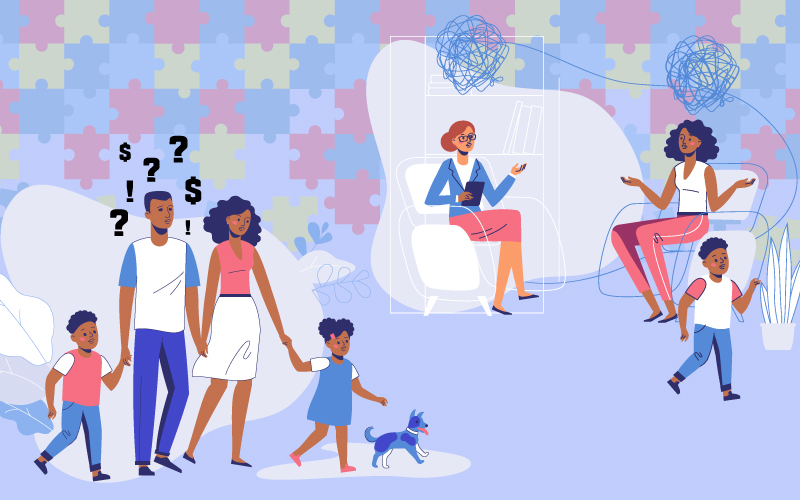The Prevalence of Autism Spectrum Disorder
Often the difference between living a healthy or unhealthy life and sometimes even the difference between life or death boils down to accessibility to healthcare. When examining the demographic of who has adequate access to healthcare, data reveals that race and class play the largest part in healthcare accessibility. These barriers directly affect the diagnosis of autism and persist in black and Hispanic communities.
In 2016 the Autism and Developmental Disabilities Monitoring (ADDM) Network estimates Autism Spectrum Disorder (ASD) prevalence in 8 year old children was 1 in 54. This same surveillance program established that ASD is equally prevalent between black and white children; however, there are disparities in early evaluation and diagnosis of ASD in black children compared to white children.

Steps to a Diagnosis
Getting an autism diagnosis takes time: According to the CDC the general process to diagnosing autism is as follows:
- Caretakers observe how the child grows in a process called Developmental Monitoring: to be sure the child is achieving developmental milestones.
- The caretaker then must book and attend regular child wellness visits (the American Academy of Pediatrics (AAP) recommends visits at the age of 9 months, 18 months, and 30 months) that include developmental monitoring and may include developmental screening.
- The child receives Developmental Screening from a healthcare professional in the form of a questionnaire or brief test that does not diagnose autism but indicates if a child is on the right developmental path or needs a formal evaluation by a specialist.
- A specialist makes a formal evaluation of the child. This may take more than one visit, may result in a misdiagnosis, or it may take more than one specialist evaluation.
Although ASD can sometimes be detected as early as 18 months; often, it goes undetected until much older. Meaning, children with ASD are likely not getting the early help they need to develop vital skills. Unfortunately, lower-class minority children experience late diagnoses more often than their upper-class white counterparts.
Many factors contribute to this health disparity including lack of resources. Clear disparities exist in rates of health insurance coverage, lack of paid leave, lack of access to transportation, and lack of funds to cover healthcare costs among black and Latino population groups. These deterrents prevent families from getting healthcare access their child needs to diagnose and treat ASD. Upper-class families have more resources and connections to speed up the process to get the special attention their child needs to diagnose and treat ASD.

Misdiagnosis Among Lower-class Minority Children
Not only are lower-class minority children getting ASD diagnosis later than their white counterparts, but they are also more often getting misdiagnosed for a behavioral issue rather than ASD. Lower-class minority children are more likely to be diagnosed with behavior issues like ADHD, conduct disorder, or adjustment disorder before they are diagnosed with autism. A study by the Center for Autism and Developmental Disabilities Research and Epidemiology distinguished that African-Americans were 2.6 times less likely than white children to receive an autism diagnosis on their first specialized care visit. The frequent misdiagnosis of autism in minorities highlights a problem in screening tools, screening accessibility, and the accessibility of healthcare screening tools because there is no difference in the number of children with autism when blacks are whites are compared, but white children are still being diagnosed earlier. Could this misdiagnosis be a product of unconscious implicit bias in healthcare?
“We physicians can no longer turn a blind eye to racial disparities in our health care system. Acting like everyone is treated equally disrespects the struggles of our minority patients and allows us to continue in blissful ignorance instead of trying to do better. We must start trying to change any discriminatory care within our control.” Writes Dr. Sandra Scott Simons in her article titled “The Racial Biases Lurking in Our Subconscious.”
Dr. Simons references the book “Just Medicine: A Cure for Racial Inequality in American Health Care” by Dayna Bowen Matthew as she continues “once (a physician) becomes aware of the automatic cognitive processes that lead to inadvertent discrimination, it’s possible to change…When physicians recognize their own unintentional bias, they are able to neutralize its impact on treatment decisions. “
Effects of Structural Racism
Structural pillars of systematic racism were identified 30 years ago as an underlying cause of health inequities. These include but are not limited to employment discrimination, mass incarceration, substandard public education, and redlining. Decades of historical practices in housing discrimination, or redlining, have had lasting impacts on health disparities within communities of color.
Redlining started in the 1930s as a policy that lenders used to outline “financially undesirable neighborhoods,” which were defined as populated by minority and foreign families. These areas were colored in red on maps and essentially prevented residents from moving to a better-resourced neighborhood. Redlining allowed lenders to deny a creditworthy applicant a loan for housing in certain neighborhoods even though the applicant may otherwise be eligible for the loan, making the move to a neighborhood with high-quality healthcare resources impossible. The Fair Housing Act was passed a mere 52 years ago to prevent redlining; however, the negative consequences of decades upon decades of this system continues to manifest in health disparities among lower-class minority communities.
Redlining kept minorities out of white, well-resourced neighborhoods that commonly had better quality facilities for diagnosing illnesses or disorders and had providers who were better trained for recognizing developmental disabilities, like autism.
Better physicians in other neighborhoods mean minority parents of the lower class must travel farther to access quality primary care physicians and specialists. This poses a logistical problem if that family does not have access to a vehicle, making transportation to other neighborhoods potentially impossible.
Affordability and Medicaid
Finally, after getting physical access to the treatment and intervention, affordability is a major factor in accessing care. Many African Americans and non-white Hispanics are under Medicaid coverage which may deny coverage to treatments and interventions the parent or physician deems necessary. Comparably, individuals with private insurance may cover it or pay out of pocket.

We can do better
The first thing that can be done is to understand that disparities between classes can be connected and exacerbated by race. Putting more minorities in positions where they can be the ones to identify other minorities can also help delineate from implicit biases. Also, cultural competence training is a way to learn more about implicit bias and ways to better serve patients without unintentionally hurting them. Policy work can be a great tool to help increase the number of physicians in poor neighborhoods and to alleviate the cost of treatment. It is time to broaden the horizon of what contributes to health disparities and better scrutinize why they can persist, only then can we truly do our patients justice.
Written by Caleb Graham
Edited by Megan Brown
References
Begeer, S., Koot, H. M., Terwogt, M. M., Boussaid, W., & Bouk, S. E. (2008, July 4). Underdiagnosis and referral bias of autism in ethnic minorities. Retrieved November 13, 2020, from https://pubmed.ncbi.nlm.nih.gov/18600440/
Bulatao, R. (1970, January 01). Health Care. Retrieved November 13, 2020, from https://www.ncbi.nlm.nih.gov/books/NBK24693/
Car Access: National Equity Atlas. (n.d.). Retrieved November 13, 2020, from https://nationalequityatlas.org/indicators/Car_access
Constantino, J., Abbacchi, A., Saulnier, C., Klaiman, C., Mandell, D., Zhang, Y., . . . Geschwind, D. (2020, September 01). Timing of the Diagnosis of Autism in African American Children. Retrieved November 13, 2020, from https://pediatrics.aappublications.org/content/146/3/e20193629
FitzGerald, C., & Hurst, S. (2017, March 1). Implicit bias in healthcare professionals: A systematic review. Retrieved November 13, 2020, from https://www.ncbi.nlm.nih.gov/pmc/articles/PMC5333436/
Mandell, D. S., Novak, M. M., & Zubritsky, C. D. (2005, December). Factors associated with age of diagnosis among children with autism spectrum disorders. Retrieved November 13, 2020, from https://pubmed.ncbi.nlm.nih.gov/16322174/
Mandell, D., Wiggins, L., Carpenter, L., Daniels, J., DiGuiseppi, C., Durkin, M., . . . Kirby, R. (2009, March). Racial/ethnic disparities in the identification of children with autism spectrum disorders. Retrieved November 13, 2020, from https://www.ncbi.nlm.nih.gov/pmc/articles/PMC2661453/
Riley, W. (2012). Health disparities: Gaps in access, quality and affordability of medical care. Retrieved November 13, 2020, from https://www.ncbi.nlm.nih.gov/pmc/articles/PMC3540621/
Tek, S., & Landa, R. (2012, September). Differences in autism symptoms between minority and non-minority toddlers. Retrieved November 13, 2020, from https://www.ncbi.nlm.nih.gov/pmc/articles/PMC3402594/
Yearby, R. (2018, October 29). Racial Disparities in Health Status and Access to Healthcare: The Continuation of Inequality in the United States Due to Structural Racism. Retrieved November 13, 2020, from https://onlinelibrary.wiley.com/doi/abs/10.1111/ajes.12230


Trackbacks/Pingbacks